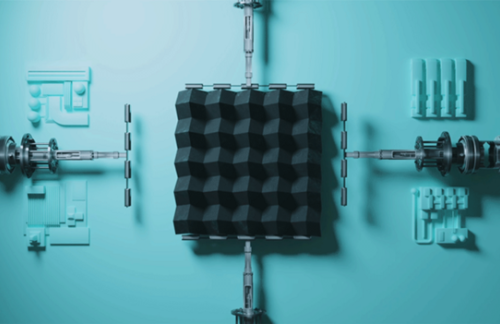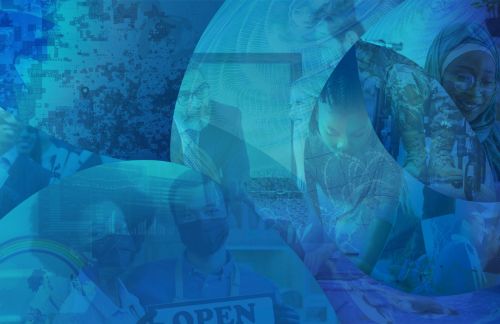
Find NSF contracting opportunities
NSF's current contracting opportunities and announcements can be found on SAM.gov.
Go to SAM.govSolicitation
NSF issues a solicitation on SAM.gov, which outlines the foundation's requirements and invites bids or proposals from businesses.
Evaluation and award
NSF reviews proposals, sets the competitive range, conducts negotiations with bidders and awards the contract to its selected awardee.
Implementation
NSF monitors contract compliance and performance, approves invoices and payments, and modifies or terminates contracts, where necessary.

Assistance for small businesses
NSF offers extensive opportunities for small and small disadvantaged businesses to participate in the foundation's acquisitions.
Learn moreNSF relies a great deal on the use of consolidated purchasing programs, such as GSA Schedules, government-wide acquisition contracts and other multiple award vehicles. NSF's contracts are typically exclusively negotiated.
The foundation commonly uses the selection techniques and award types listed below:
1. Micropurchases:
NSF may make purchases without soliciting competitive quotations if the purchase price is reasonable and below the current micro-purchase threshold defined at FAR 2.101. NSF often uses purchase cards for its micro-purchases.
2. Simplified acquisitions:
NSF may use simplified procedures, with reduced contract clause requirements, for purchases that are greater than the micro-purchase threshold but less than or equal to the simplified acquisition threshold defined at FAR 2.101.
3. Acquisitions above the simplified acquisition threshold:
For acquisitions that exceed the simplified acquisition threshold defined at FAR 2.101, NSF's contracting officers use three methods, described below:
With this method, sealed bids are submitted to NSF, which are publicly opened. Award goes to the low, responsive, responsible bidder.
With this method, NSF issues a request for proposals, discusses proposals with offerors in the competitive range, and awards based on the evaluation criteria outlined in the solicitation.
This method is only permitted only when a contract meets statutory exceptions to competition, such as urgency or lack of any other responsible source.
NSF uses Federal Acquisition Regulations (FAR)-based contracts and non-FAR-based contracts for its procurement needs.
FAR-based contracts
A type of contract that provides for a firm price or, under appropriate circumstances, for an adjustable price for the supplies or services being procured.
Time and materials contracts are a type of contract that provides for acquiring supplies or services based on:
- Direct labor hours at specified fixed hourly rates that include wages, overhead, general and administrative expenses and profit.
- Actual cost for materials.
A labor-hour contract is a variation of the time-and-materials contract, differing only in that materials are not supplied by the contractor.
Costs incurred in the contract performance to the extent prescribed in the contract. These contracts may not require completion of the contract work, but rather the best efforts of the contractor. The types of cost reimbursement contracts include:
- Cost.
- Cost-plus-fixed-fee (CPFF).
- Cost-plus-incentive fee (CPIF).
- Cost-plus-award fee (CPAF).
A tool used for acquisition of basic and applied research. BAAs focus on advancing the state-of-the-art or increasing knowledge or understanding — not on a specific system or hardware solution. Visit NSF's Broad Agency Announcements webpage for more information.
Non-FAR-based instruments
NSF generally uses other arrangements for binding non-assistance, contract-like instruments. These arrangements are used for many purposes and are generally intended to be contractual in nature. They generally possess the requirements for a valid, enforceable contract with the United States; these are:
- Mutuality of intent to contract.
- Offer and acceptance.
- Consideration.
Procurement instruments other than contracts, grants or cooperative agreements that are used for the acquisition of applied research focusing on technology advancement or rapid prototype development.
Senior Procurement Executive:
Patrick Breen: pkbreen@nsf.gov
Manages the direction of NSF's acquisition system, including NSF's unique acquisition policies, regulations and standards.
Acquisition Innovation Advocate:
Raymond McCollum: rmccollu@nsf.gov
Encourages testing of new ideas and better ways of executing existing acquisition practices at NSF.
Head of Contracting Activity:
Bethany Petrofsky: bpetrofs@nsf.gov
Manages NSF's contracting activities.
Competitive Advocate:
Jason Bossie: jbossie@nsf.gov
Promotes full and open competition for the purchase of goods and services at NSF.
Director of the Office of Small and Disadvantaged Business Utilization:
Wonzie Gardner: osdbu@nsf.gov
Provides small and small disadvantaged businesses with opportunities to participate in NSF acquisitions.
Comments or complaints
About regulatory or enforcement actions:
Small businesses may direct comments to the Small Business Administration's Office of the National Ombudsman:
- Email: ombudsman@sba.gov
- Phone: 1-888-REG-FAIR
- Mail: SBA Office of the National Ombudsman, 409 Third St. SW, Washington, D.C., 20416
Note: The National Ombudsman process has no effect on your rights or obligations under the agency on which you are commenting. You must still comply with all of NSF's processes and procedures.
About task or delivery orders:
Contractor complaints about task-orders and delivery-orders executed under procedures set forth in FAR 16.505 can be directed to:
- Email: NSFAcquisitionOmbuds@nsf.gov
- Phone: (703) 292-8200
NSF's Task-Order and Delivery-Order Ombudsman reviews complaints and ensures they have a fair opportunity to be considered, consistent with the procedures in the applicable contract.
Note: The NSF Acquisition Ombudsman has no authority to review complaints that relate to matters beyond 41 U.S.C § 4106(g) and/or FAR 16.505(b)(8).
NSF service contract inventory
NSF's annual service contract inventory data is included in the government-wide inventory posted on acquisition.gov; the government-wide inventory can be filtered to display data for NSF.
NSF's annual inventory analyses determine if the mix of federal employees and contractors is effective or requires rebalancing. They can be found below:
- FY 2022 NSF Inventory Analysis including FY 2023 Analysis Plan (NSF 23-007)
- FY 2021 NSF Inventory Analysis including FY 2022 Analysis Plan (NSF 22-112)
- FY 2020 NSF Inventory Analysis including FY 2021 Analysis Plan (NSF 22-020)
- FY 2019 NSF Inventory Analysis including FY 2020 Analysis Plan (NSF 21-106)
- FY 2017 NSF Inventory Analysis including FY 2018 Analysis Plan (NSF 20-103)
- FY 2016 NSF Inventory Analysis including FY 2017 Analysis Plan (NSF 20-102)
- FY 2015 NSF Inventory Analysis including FY 2016 Analysis Plan (NSF 17-133)
